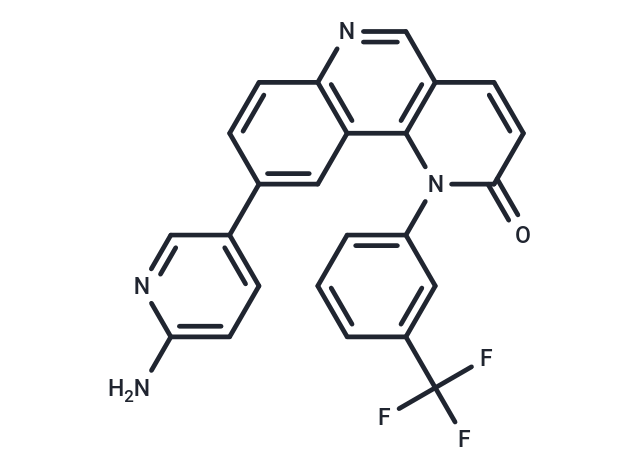Shopping Cart
- Remove All
 Your shopping cart is currently empty
Your shopping cart is currently empty

Torin 2(IC50=0.25 nM), a specific and effective mTOR inhibitor, is the 800-fold greater specific activity for mTOR than PI3K and improves pharmacokinetic properties. The EC50 of Torin 2 for ATM/ATR/DNA-PK inhibition is 28 nM/35 nM/118 nM, respectively.

| Pack Size | Price | Availability | Quantity |
|---|---|---|---|
| 2 mg | $35 | In Stock | |
| 5 mg | $56 | In Stock | |
| 10 mg | $93 | In Stock | |
| 25 mg | $169 | In Stock | |
| 50 mg | $271 | In Stock | |
| 100 mg | $401 | In Stock | |
| 200 mg | $597 | In Stock | |
| 500 mg | $953 | In Stock |
| Description | Torin 2(IC50=0.25 nM), a specific and effective mTOR inhibitor, is the 800-fold greater specific activity for mTOR than PI3K and improves pharmacokinetic properties. The EC50 of Torin 2 for ATM/ATR/DNA-PK inhibition is 28 nM/35 nM/118 nM, respectively. |
| Targets&IC50 | mTOR:0.25 nM, ATR:35 nM(EC50), DNA-PK:118 nM(EC50), ATM:28 nM(EC50) |
| In vitro | In Th-MYCN mice, Torin 2 (20 mg/kg) eradicated MYCN tumors, decreased MYCN protein levels, and induced apoptosis. In liver microsome stability assays, Torin 2 demonstrated greater than 95% pharmacological response with a half-life of 11.7 minutes. The best bioavailability of Torin 2 in male Swiss albino mice, whether administered intravenously or orally, was 51%, with a half-life of 0.72 hours and a low clearance rate of 19.6 mL/min/kg. |
| In vivo | In MZ-CRC-1 and TT cells, Torin 2 (at concentrations < 50 nM) significantly reduces cell viability, while at 100 nM, it notably decreases cell migration. Torin 2 inhibits mTORC1, thus activating TFEB by promoting its nuclear translocation, with an EC50 value of 1.666 mM. Its mechanism involves a similar binding pattern to PI3Kγ, with V882 serving as a pivotal hinge binding site. This interaction is further stabilized by three hydrogen bonds from Y867, D841, and D964 targeting amino benzyl side chains, mirroring the interaction seen with mTOR’s Y2225, D2195, and D2357. |
| Kinase Assay | mTOR and PI3K Cellular Assays: Cellular IC50 values for mTOR are determined using p53?/? MEFs. Cells are treated with vehicle or increasing concentrations of Torin 2 for 1 h and then lyse. Phosphorylation of S6K1 Thr-389 is monitored by immunoblotting using a phospho-specific antibody. Meanwhile, cellular IC50 values for PI3Ka are determined based on phosphorylation of Akt Thr-308 in p53?/?/mLST8?/? MEFs or human PC3 cells expressing the S473D mutant of Akt1. |
| Cell Research | For viability, MZ-CRC-1 and TT cells are seeded in quadruplicate in 96-well plates (1.0×104 cells per well) in culture media with 2.5% and 4% FBS, respectively. After 24 hours, cells are treated with Torin 2. At the indicated time point, cells are incubated for 3 hours with 10 μL of CellTiter96 AQueous One solution in 100 μL of culture media and absorbance is measured at 490 nm.(Only for Reference) |
| Molecular Weight | 432.4 |
| Formula | C24H15F3N4O |
| Cas No. | 1223001-51-1 |
| Smiles | Nc1ccc(cn1)-c1ccc2ncc3ccc(=O)n(-c4cccc(c4)C(F)(F)F)c3c2c1 |
| Relative Density. | 1.427 g/cm3 |
| Storage | Powder: -20°C for 3 years | In solvent: -80°C for 1 year | Shipping with blue ice. | ||||||||||
| Solubility Information | DMSO: 1 mg/mL (2.31 mM), Sonication is recommended. | ||||||||||
Solution Preparation Table | |||||||||||
DMSO
| |||||||||||

Copyright © 2015-2025 TargetMol Chemicals Inc. All Rights Reserved.